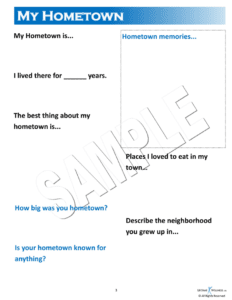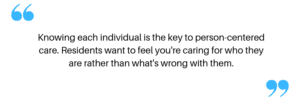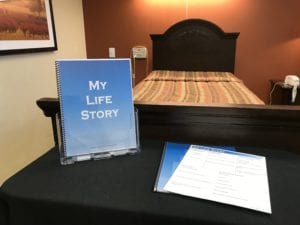Each of us has a unique identity and life story. Seniors, in particular, have lived many life chapters – and typically welcome the opportunity to reminisce and share life learnings. A resource from Lifetime Wellness helps senior living providers get to know their residents’ life stories and build a person-centered care plan that can help make life more familiar and comfortable.
“We believe there is no greater gift than human connection,” says Susan McKinney, vice president of operations at Lifetime Wellness, a certified dementia practitioner and trainer, and a recreational therapist. “Our life story resources foster deep connections among residents, families, and caregivers. They also support social interaction, memory activation, and wellness as a way of life.” The Life Story resources can be used in any senior living setting – from independent living to assisted living, memory care to skilled nursing –and include best practice recommendations.
Introducing the Life Story Page

Lifetime Wellness provides a Life Story Page resource that makes it easy for all caregivers to know more about the life behind who they are caring for. “It’s designed to be an easily accessible one-page reference tool,” McKinney says. “It’s placed at the bedside so all can know essential information instantly, from the resident’s family members to favorite food, music, and pastimes. Seeing each resident more holistically can help personalize care and enhance the resident experience.”
The resource is available in two card stock size options, 8 1⁄2 x 11 or 11 x 17, with an optional acrylic holder. Senior care staff gather information from residents and family members before admission and at admission. “The Life Story Page can streamline care transitions, ensuring everyone knows more about the whole person. For example, if a resident moves from an assisted living setting to memory care, it’s important that detailed biographical information is transferred to caregiving staff.”

Incorporating the Life Story Book
Lifetime Wellness also offers a Life Story Book. This 52-week tool goes into more depth on different topics important to each resident, from educational and vocational background to hobbies and holidays – creating a living legacy.
 “Knowing each individual is the key to person-centered care,” McKinney says. “Residents want to feel you’re caring for who they are rather than what’s wrong with them. The Life Story resources are particularly helpful for those living with dementia because, with cognitive loss, they can’t always voice their needs or choices.”
“Knowing each individual is the key to person-centered care,” McKinney says. “Residents want to feel you’re caring for who they are rather than what’s wrong with them. The Life Story resources are particularly helpful for those living with dementia because, with cognitive loss, they can’t always voice their needs or choices.”
Included in the spiral-bound book are such topics as life story overview, family, occupation, education, leisure and recreation, holidays, and seasons. Topics can be reviewed individually, one-on-one, or in a group setting. Life Story socials are held periodically, bringing residents together to discuss the topic of the week – for example, “what I remember about my hometown” or “my best vacation.”
McKinney tells the story of two residents in a Life Story social who discovered they went to the same high school, graduating just two years apart. “They developed an instant bond, reminiscing about their youth and teachers they had in common. The socials are a great way to foster that kind of bonding.”
Involving the Family
A best practice in the Life Story program is involving the family. ”Families can help fill in the blanks in personal information,” McKinney says. “The Life Story Book opens the door to a meaningful visit. It serves as a conversation starter for family and friend interactions. It’s also a way to stimulate the connection between generations. Seniors have an opportunity to inform their children and grandchildren – sharing wisdom and lessons learned throughout the years.”
Another best practice is using the Life Story program as a tool for redirection with loved ones living with dementia. “If a resident becomes agitated, the book can serve as a guide to refocus their attention in a positive way. Ultimately, it’s a daily tool that can reawaken memories, bring meaning and purpose, and enhance each resident’s quality of life.”